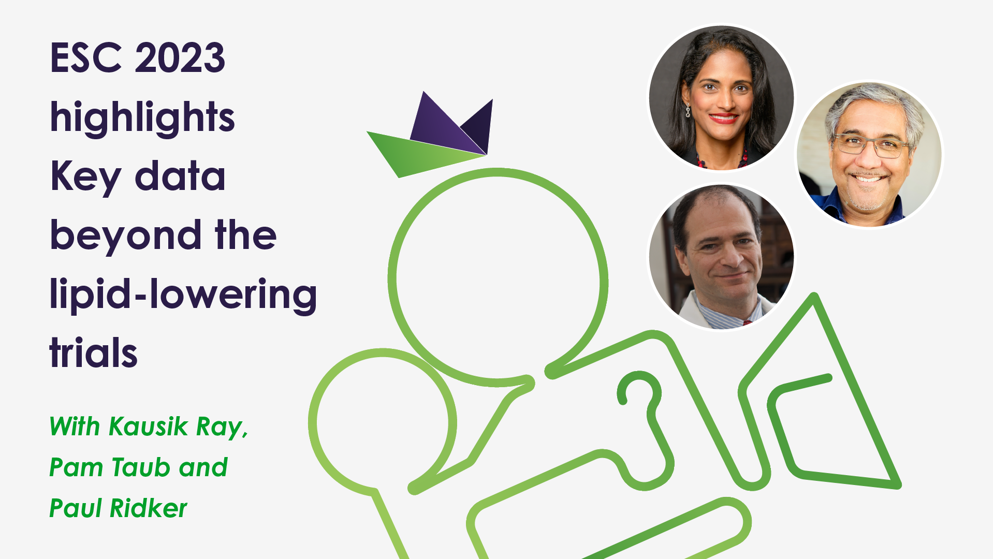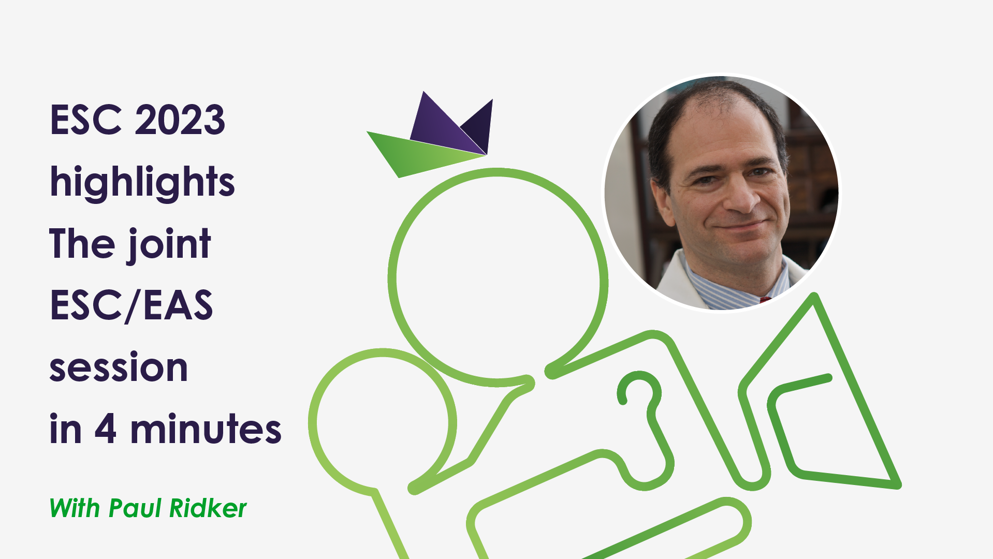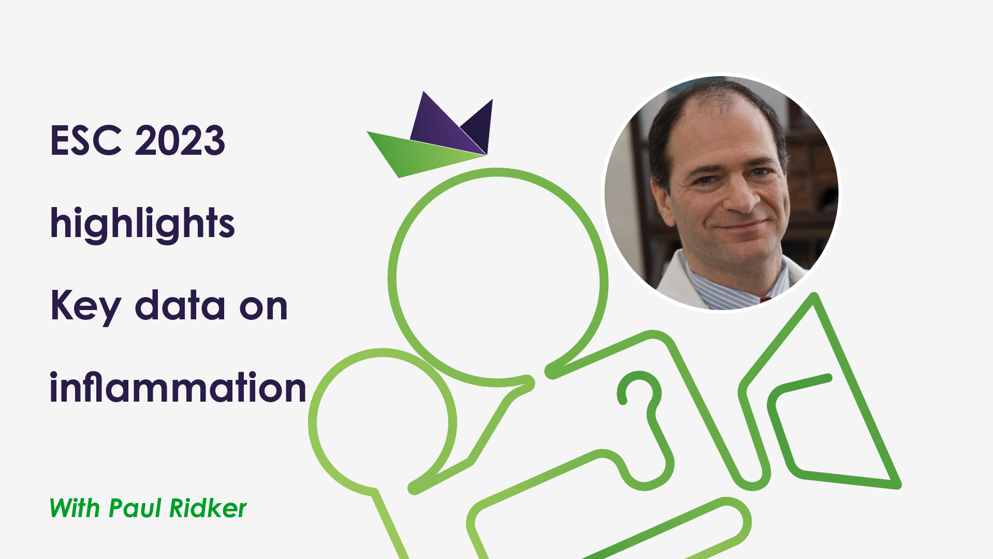
ESC 2023
Trial data and real-world lipid management
By Eleanor McDermid
This year’s ESC conference featured trial data for both approved and in-development interventions for lipid lowering, along with clinical studies highlighting practical aspects of lipid management.
Paul Ridker and Stephen Nicholls discuss the problems created by the need for combination therapy and how healthcare professionals may address them.
Beyond the lipid-lowering trials: Paul Ridker, Pam Taub and Kausik Ray highlight important data presented outside of the clinical trial update sessions.
Insights into lipid and ASCVD management
Lipid target hits and misses
Just 31% of 400 people had their low-density lipoprotein (LDL) cholesterol within target 6 months or more after being treated for myocardial infarction in a tertiary hospital, show data presented in an abstract session by Daniel Gomes (Hospital de Santa Cruz, Lisbon, Portugal).
Only 26% of people not at target had their lipid-lowering medication adjusted, and their next clinic appointment was a median of 8 months away, suggesting little urgency about achieving control of cholesterol in this high-risk group.
Lipid target attainment is uncommon, even in high-risk groups, despite the demonstrated benefit of large LDL cholesterol reductions
The importance of intensive lipid management was illustrated by a population-based study of 16,055 people at high atherosclerotic cardiovascular disease (ASCVD) risk who were prescribed a lipid-lowering therapy.
Those who achieved an LDL cholesterol reduction of 50% or greater had a significant 56% reduction in the risk of major adverse cardiovascular events (MACE) relative to those with no change or an increase over 24 months of follow-up. But the risk reduction in people with a smaller LDL cholesterol increase was not significant, reported Cristina Gavina (Hospital Pedro Hispano, Porto, Portugal) in a poster session.
Data presented in another poster by Richard Summers (Swansea University, UK) highlighted the need to account for mental health when treating high cholesterol in people with ASCVD.
The researchers found that people with depression were more likely to have their lipid levels checked than those without (51.7% vs 46.8% in 2019) and to be taking lipid-lowering therapy (e.g., 22.5% vs 17.7% on a high-intensity statin). Yet these people were significantly less likely to be at target for triglycerides, LDL cholesterol and non-high-density lipoprotein (HDL) cholesterol.
People with depression may find it particularly challenging to achieve lipid goals
Patient factors
Several poster presentations focused on specific characteristics of people with dyslipidaemia.
The Cycle study researchers studied lipid levels in relation to menstrual cycle and oral contraception use in 28 women with familial hypercholesterolemia (FH) and 69 without. They found that levels of total, LDL and HDL cholesterol were generally highest at the time of ovulation, with these fluctuations being most marked in women with FH who were not taking a statin.
Janneke Mulder (University Center Rotterdam, the Netherlands) and co-researchers also showed that total and LDL cholesterol levels rose in women during the 12–14 days of the month when they were taking the contraceptive pill. They therefore suggested that untreated women with FH and those taking oral contraception should have their lipid levels measured at a set time in their menstrual cycle.
Another study looked at lipoprotein(a) – or Lp(a) – in people undergoing cardiac rehabilitation following a coronary artery disease event. The researchers found that while women comprised 21.2% of the whole cohort of 518 people, they accounted for 27.7% of those with Lp(a) levels greater than 50 mg/dL and 32.1% of those with levels above 100 mg/dL. Indeed, female sex was the only factor independently associated with increased Lp(a).
Participants with the highest levels were given a PCSK9 inhibitor. Marko Novaković (University Medical Centre Ljubljana, Slovenia) reported that having a lower BMI and being a non-smoker were associated with a larger reduction in Lp(a) levels in this subgroup, and suggested that addressing these lifestyle factors might improve treatment response.
Finally, a presentation from Andrew Black (University of Tasmania, Australia) highlighted the importance of considering the presence of FH in people who require coronary artery bypass surgery before the age of 60 years.
Among 590 such people, 13.6% were classified as definite FH according to the Dutch Lipid Clinic Network criteria, with a further 42.2% classified as possible FH. During follow-up lasting a median of 7.9 years, just 18.8% of participants with definite FH achieved their lipid targets, compared with 45.6% of those with no FH, and 21.3% versus 8.8% had a MACE.
Clinical trial updates
Moving on to the large trials, a prespecified secondary analysis of the CLEAR Outcomes trial showed that the benefits of bempedoic acid are consistent regardless of people’s glycaemic status. Indeed, Kausik Ray (Imperial College London, UK) reported that the largest absolute benefit was seen in participants with type 2 diabetes.
The majority (87%) of this high-risk trial population had either prediabetes or diabetes, and they had higher rates of the primary MACE outcome than the participants with normoglycaemia, with rates ranging from 11.9% to 14.2% for the 4-point MACE outcome.
Kausik Ray discusses the rationale for analysing the CLEAR Outcomes by glycaemic status and outlines the key findings
The overall absolute risk reduction with bempedoic acid versus placebo was 1.6%, but there was a statistically significant interaction of glycaemic status with the effect of bempedoic acid, such that the largest risk reduction occurred in people with diabetes, at 2.4%.
There were also new data from the ORION series of trials of the small interfering RNA medication inclisiran. R. Scott Wright (Mayo Clinic, Rochester, USA) presented the results of ORION-8, an open-label extension study of participants from ORION-3, 9, 10 or 11. This amounted to 3,274 people, with a median 3.27 years of exposure to inclisiran (maximum 6.84 years); by the end of the study, 78.4% of these had achieved the LDL cholesterol goal of below 1.8 mmol/L for the secondary prevention population or below 2.6 mmol/L for the primary prevention population.
The safety data were in line with previous findings. Anti-drug antibodies developed in 5.1% of the participants, and the presence of these was not associated with LDL reduction or safety outcomes.
Pam Taub gives an overview of the ORION-8 findings and what they mean for clinical practice
Presentations on treatments in the pipeline included one from Frederick Raal (University of the Witwatersrand, Johannesburg, South Africa), who presented the primary results of LIBerate-HeFH – a phase 3 trial of lerodalcibep in people with heterozygous FH. Lerodalcibep, a PCSK9 inhibitor, is a small binding protein so can be injected in smaller volumes than monoclonal antibodies.
During 24 weeks of treatment, the 319 participants randomised to monthly 1.2 mL injections of lerodalcibep 300 mg in addition to their existing treatments achieved an average 58.6% reduction in LDL cholesterol, relative to the 159 people taking placebo. More than 80% achieved an LDL cholesterol reduction of at least 50%, and almost 70% achieved their cholesterol goals. There was also a significant placebo-adjusted reduction in Lp(a) levels, averaging 23.9%.
Adverse event rates were similar between the active- and placebo-treatment groups, bar a higher rate of injection-site reactions in the lerodalcibep group, at 3.1% versus 0.2% after adjustment for the number of doses given. The majority of these reactions were mild.
Raal noted that the trial is now published in the European Heart Journal1.
Watch Pam Taub discuss the key messages from the phase 3 LIBerate-HeFH trial
ESC 2023 also featured updates on in-progress medications targeting Lp(a), including the results of an extended off-treatment follow-up to the phase 2 OCEAN(a)-DOSE trial of the small interfering RNA treatment olpasiran. This showed that the effect of olpasiran persisted for many months, with Lp(a) levels remaining up to approximately 45% (depending on the dose) below baseline 12 months after the final injection.
Presenter Michelle O’Donoghue (Brigham and Women’s Hospital, Boston, Massachusetts, USA) noted that the cardiovascular prevention efficacy of olpasiran is being assessed in the ongoing phase 3 OCEAN(a) Outcomes trial2. Its estimated completion date is December 2026.
A potential alternative approach to lowering Lp(a) was shown with the phase 1 findings for muvalaplin, an orally administered, small molecule inhibitor of Lp(a) that works by disrupting the bonding of apoB and apo(a).
In this trial in 114 healthy people, muvalaplin doses greater than 100 mg/day reduced Lp(a) by around 65% versus placebo over 14 days – almost all participants achieved levels below 50 mg/dL. However, presenter Stephen Nicholls (Monash University, Melbourne, Australia) noted that the actual reduction may be even larger because the assay used measures drug-bound and free apo(a) in addition to the target of apoB-bound apo(a).
There were eight adverse events considered possibly related to the study drug: headache, fatigue, vomiting and an outbreak of acne. The findings were simultaneously published in JAMA3.
What is muvalaplin and whom might it benefit? Stephen Nicholls discusses this in-development treatment and the early clinical trial findings.
Pam Taub gives her take on a phase 1 trial of an alternative approach to reducing Lp(a) levels.
References
- Raal F, Fourie N, Scott R, Blom D, De Vries Basson M, Kayikcioglu M, et al. Long-term efficacy and safety of lerodalcibep in heterozygous familial hypercholesterolaemia: the LIBerate-HeFH trial. Eur Heart J. 2023.
- Olpasiran Trials of Cardiovascular Events and Lipoprotein(a) Reduction (OCEAN(a)) - Outcomes Trial. https://clinicaltrials.gov/study/NCT05581303. Accessed 29 August.
- Nicholls SJ, Nissen SE, Fleming C, Urva S, Suico J, Berg PH, et al. Muvalaplin, an Oral Small Molecule Inhibitor of Lipoprotein(a) Formation: A Randomized Clinical Trial. JAMA. 2023.
New data and key messages
Paul Ridker and Kausik Ray highlight the most impactful research from this year’s ESC congress.
The joint ESC/EAS session on ‘Targeting the spectrum of atherogenic lipoproteins’ in 4 minutes. Paul Ridker outlines what was covered and gives the take-home messages.
Paul Ridker summarises the key conference messages on inflammation in atherosclerosis and predicts their impact on future patient care.
A state-of-the-art lecture in under 3 minutes. Stephen Nicholls sums up the key messages from his talk on risk management beyond antithrombotic therapies after percutaneous coronary intervention.
This content has been developed independently by Medthority who previously received educational funding in order to help provide its healthcare professional members with access to the highest quality medical and scientific information, education and associated relevant content.







